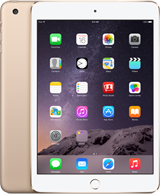Why Apple Still supports the A5 Chip


I thought I would go through all of the iPads and give a fairly complete comparison of the current iPads that are available today. Also for comparison I am including the iPads that are no longer available. This table shows some information of each of the iPads.
| no longer sold | currently sold | ||||||||
|---|---|---|---|---|---|---|---|---|---|
| iPad Model |
iPad | iPad 2 | iPad 3rd Gen |
iPad 4th Gen |
iPad Mini |
iPad Air |
iPad Mini 2 |
iPad Air 2 |
iPad Mini 3 |
| Released | Mar. 2010 | Mar. 2011 | Mar. 2012 | Oct. 2012 | Oct. 2012 | Oct. 2013 | Oct. 2013 | Oct. 2014 | Oct. 2014 |
| Processor | Apple A4 | Apple A5 | Apple A5X | Apple A6X | Apple A5 | Apple A7 | Apple A7 | Apple A8X | Apple A7 |
| Processor Speed | 1GHz Single | 1GHz Dual | 1GHz Dual | 1.4GHz Dual | 1GHz Dual | 1.4GHz Dual | 1.3GHz Dual | 1.5GHz Triple | 1.3GHz Dual |
| Memory | 256MB | 512MB | 1GB | 1GB | 1GB | 1GB | 1GB | 2GB | 1GB |
| Screen Resolution |
1024x768 | 1024x768 | 2048x1536 | 2048x1536 | 1024x768 | 2048x1536 | 2048x1536 | 2048x1536 | 2048x1536 |
| Retina Display |
No | No | Yes | Yes | No | Yes | Yes | Yes | Yes |
| Pixel Density |
132 ppi | 132 ppi | 264 ppi | 264 ppi | 132 ppi | 264 ppi | 326 ppi | 264 ppi | 326 ppi |
| GeekBench Single Core |
522 | 268 | 267 | 786 | 259 | 1492 | 1488 | 1811 | 1251 |
| GeekBench Multi-Core |
N/A | 505 | 503 | 1430 | 491 | 2701 | 2708 | 4513 | 2129 |
So what does all of this really mean? Honestly, the only items in this chart that really mean anything are the Geek Bench numbers. The reason these mean something is because the higher the number, the better the device performs. A good example is to take the difference between the iPad Mini and the iPad Mini 2. The single-core results for the iPad Mini is 259, while the multi-core is 491. The iPad Mini 2 comes in at 1488 for single core and 2708 for multi-core. These are significant jumps in performance. The biggest difference is the processor. It goes from an A5 to and A7. The A7 is two generations newer and just a better chip overall. The one thing that you will notice is that the A5 is used in 2 products, the iPad 2 and the iPad Mini. Neither of these support retina displays. The first retina iPad was the iPad 3rd Generation, which had an A5X, which could support the new retina display. Once we hit the iPad 4th Generation, which is the only iPad to have an A6 chip in it, of any sort (the iPhone 5 and 5C both use the A6 chip).
Developers were hoping that the iPad Mini would have been discontinued and would relieve developers of the burden of supporting the A5 chipset when iOS 9 comes out. But that does not look to be the case. Apple may choose to no longer support the iPad Mini with iOS 9 but only time will tell if this turns out to be true.
Why would Apple keep the A5 chip? Could Apple not upgrade the processor to an A6, to bring better performance. If Apple would have done this, it would have brought better performance and a better experience for users and developers. However, Apple is fabricating the dual-core A5 chips for their iPod Touch and it makes more sense to fabricate the same chip for both devices. Because both of these devices use the same processor, Apple is expecting developers to support the A5 chip.
Because Apple is still selling devices that include the A5 chip, the iPad 2 and iPad Mini are still supported with iOS 8 and iOS 8.1. If Apple is still selling devices that developers can build applications for, that has the A5 in it, Apple will likely support the A5 on iOS 9. I am hoping that they do not do this.


